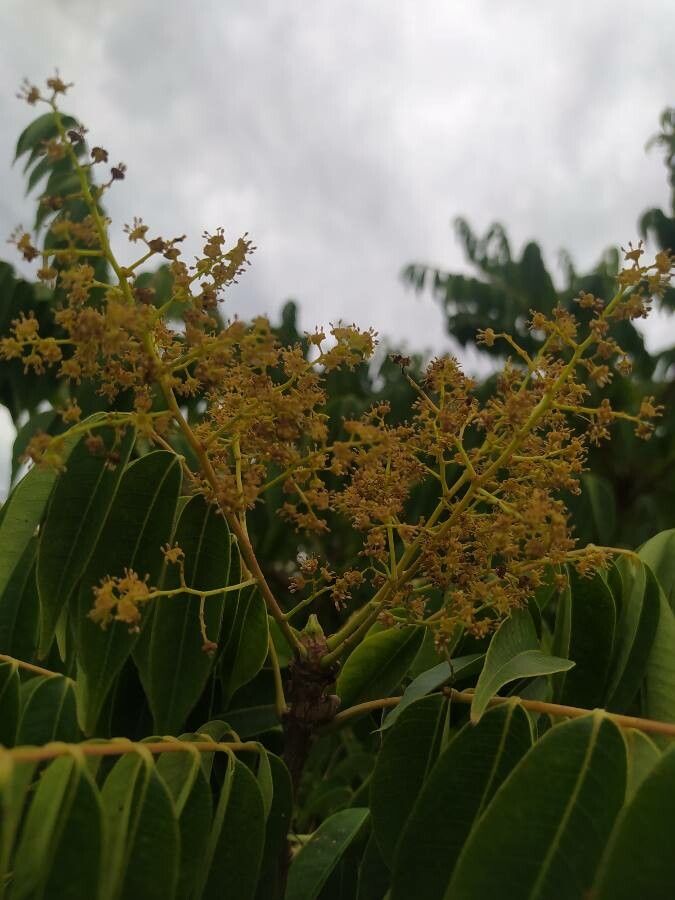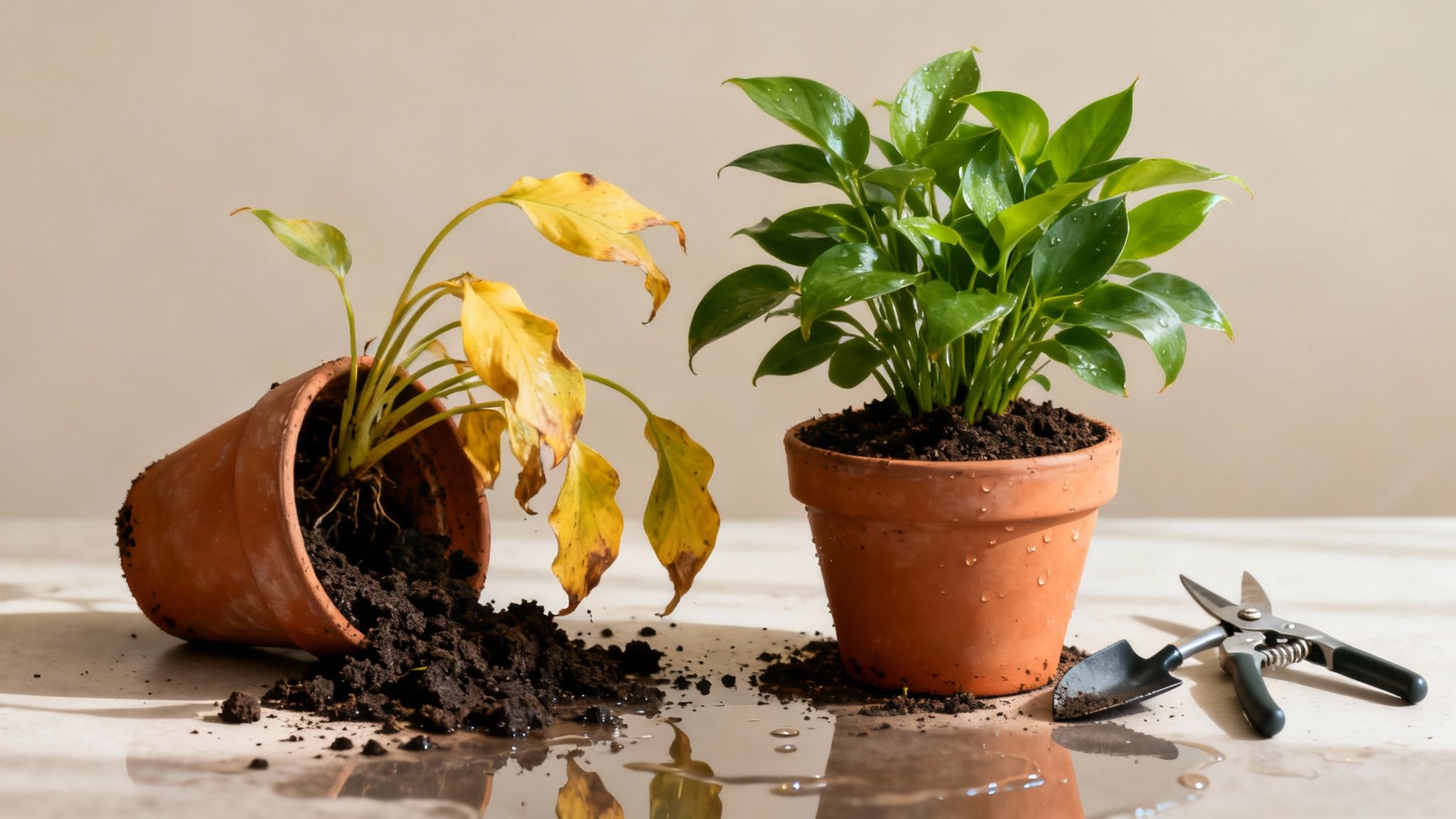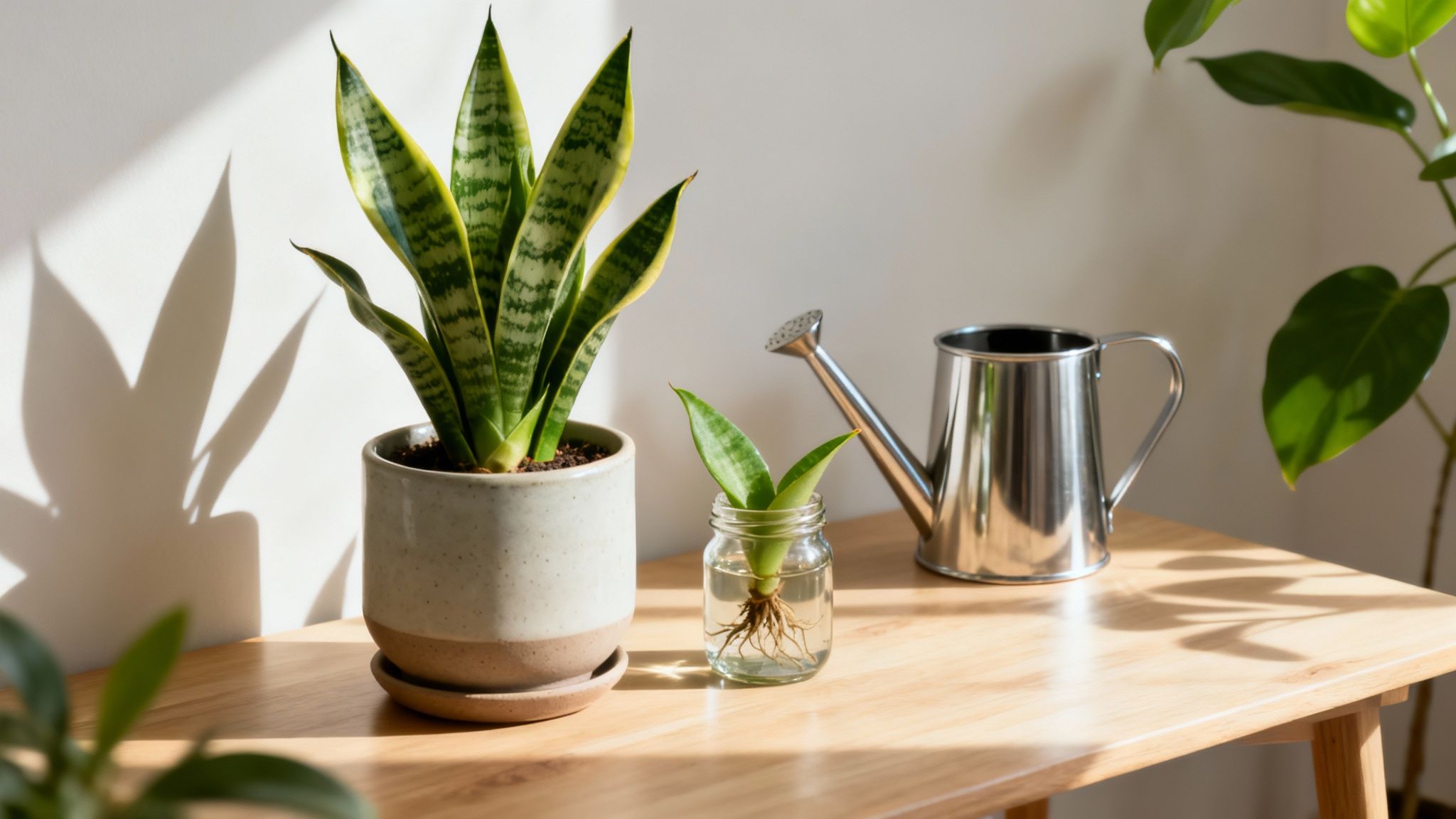Have you ever brought home a beautiful plant, only to watch it slowly lose its spark? For many, the dream of a lush indoor jungle can feel just out of reach. Enter the Pothos (Epipremnum aureum), the nearly indestructible trailing vine that makes green-thumb aspirations a reality. It's the perfect companion for both nervous first-timers and seasoned gardeners. This comprehensive pothos care guide is your complete roadmap to helping your Pothos not just survive, but truly thrive.
Welcome to the wonderful world of Pothos, a classic houseplant celebrated for its forgiving nature and stunning foliage. More than just decor, it’s an invitation to bring the calming presence of nature indoors. Its incredible resilience is why it’s often the first step for many on their plant care journey. But even the toughest plants benefit from a little know-how. Ever found a beautiful Pothos but weren't sure which variety it was? The Tendra app’s AI plant identification can tell you in seconds, unlocking a world of specific care tailored to your new friend. This guide will walk you through everything from light and water to pruning and creating new plants, ensuring you can grow with confidence.
Why Is Pothos So Popular?
The enduring popularity of the Pothos is no accident—it's a testament to its incredible adaptability and charm. This plant consistently ranks among the top five most purchased houseplants across North America and Europe. In fact, with the boom of online plant shops, overall houseplant popularity has jumped by a surprising 35% over the last five years, with Pothos leading the charge.
But its easy-going reputation is just the start. Pothos offers real, tangible benefits that fit right into modern life.
- Natural Air-Purifier: It's well-known for its ability to filter common pollutants from indoor air.
- Aesthetic Versatility: Its trailing vines are incredibly versatile. You can let them cascade from hanging baskets, train them to climb up a moss pole, or drape them elegantly over shelves and bookcases.
- Incredibly Forgiving: It tolerates a huge range of conditions, from low light to the occasional forgotten watering, which makes it perfect for beginners.
Creating the Perfect Pothos Environment: A Complete Guide

To really make your Pothos happy, you have to start thinking like a plant. Imagine its natural home: a lush, warm forest floor, getting bits of dappled sunlight through the canopy. The good news is, you don't need a rainforest in your living room to make it feel at home.
It all boils down to three key pillars: light, water, and soil. Get these right, and you're not just keeping your Pothos alive—you're helping it truly flourish. Let's dig into exactly what that looks like.
Finding the Sweet Spot for Light
Pothos has a rock-solid reputation as a low-light champion, but that’s a bit of a misunderstanding. It's more "low-light tolerant" than "low-light loving." While it will survive in a dim corner, to see that vibrant color and vigorous growth, it needs bright, indirect light.
So, what does "bright, indirect light" actually mean in your home?
- Think about a spot a few feet back from an east-facing window that catches that soft morning sun.
- Or the gentle, consistent brightness you get near a north-facing window all day long.
- It could even be the light in a sunny south or west-facing room, but filtered through a sheer curtain to soften the harsh afternoon rays.
Direct sun is the enemy; it’s like a sunburn for your plant, causing scorched leaves or pale, washed-out color. On the flip side, too little light will slow its growth and can cause variegated beauties like the 'Marble Queen' to lose their stunning patterns and revert to solid green.
The Art of Watering Your Pothos
If there’s one mistake new plant parents make, it's killing with kindness—specifically, too much water. Pothos dislike having constantly "wet feet." They much prefer their soil to dry out a bit between waterings. This simple "drench and dry" method is your best defense against root rot.
Forget watering on a strict schedule. Your plant will tell you when it's thirsty, and your best tool is your finger. Just poke it about an inch or two (2.5-5 cm) into the soil. If it comes out dry, it's time to water. If you still feel moisture, give it another day or two and check again. It's that simple.
When you do water, be thorough. Let water run through the soil until you see it flowing freely from the pot's drainage holes. This ensures the entire root system gets a good drink. Just be sure to let it drain completely before putting it back in its decorative pot or saucer.
Surprising Fact: The Pothos's scientific name, Epipremnum aureum, has been a source of botanical debate for years. It was originally classified as a Pothos, then a Scindapsus, and has been reclassified multiple times. This identity crisis mirrors care.htm">its adaptability at Gardening Know How to almost any indoor environment.
Crafting the Ideal Soil Mix
The right soil is your secret weapon against overwatering. Pothos roots need to breathe, and a dense, compacted soil mix can suffocate them. Your goal is a potting blend that's light, airy, and drains like a charm.
You can find pre-made aroid mixes at most garden centers, but mixing your own is easy and gives you perfect results. A simple three-part recipe works wonders:
- Standard Potting Mix (about 2 parts): This is your base, providing nutrients and structure.
- Perlite (about 1 part): Those little white rocks are volcanic glass, fantastic for creating air pockets that boost aeration and drainage.
- Orchid Bark (about 1 part): Chunky bits of bark keep the mix from getting compacted and help replicate that forest floor environment Pothos loves.
This blend holds just enough moisture without ever becoming waterlogged. And always use a pot with drainage holes. It's non-negotiable for giving your Pothos the healthy foundation it needs.
Pothos Environmental Needs at a Glance
| Care Factor | Ideal Condition | Signs of Trouble |
|---|---|---|
| Light | Bright, indirect light for several hours a day. | Too Much: Scorched, yellowing, or pale leaves. Too Little: Leggy growth, loss of variegation. |
| Water | Water thoroughly when the top 1-2 inches (2.5-5 cm) of soil are dry. | Overwatering: Yellow leaves, mushy stems, root rot. Underwatering: Wilting, crispy brown leaf edges. |
| Soil | A chunky, well-draining mix (e.g., potting soil, perlite, and orchid bark). | A dense, soggy mix can lead to root rot; a compacted mix restricts root growth. |
| Humidity | Prefers 40-60% humidity but is highly adaptable to average household levels. | Brown, crispy leaf tips can indicate air that's too dry. |
Getting these basics right is truly 80% of the battle. Once you nail the environment, everything else becomes much easier.
Mastering Pruning and Propagation
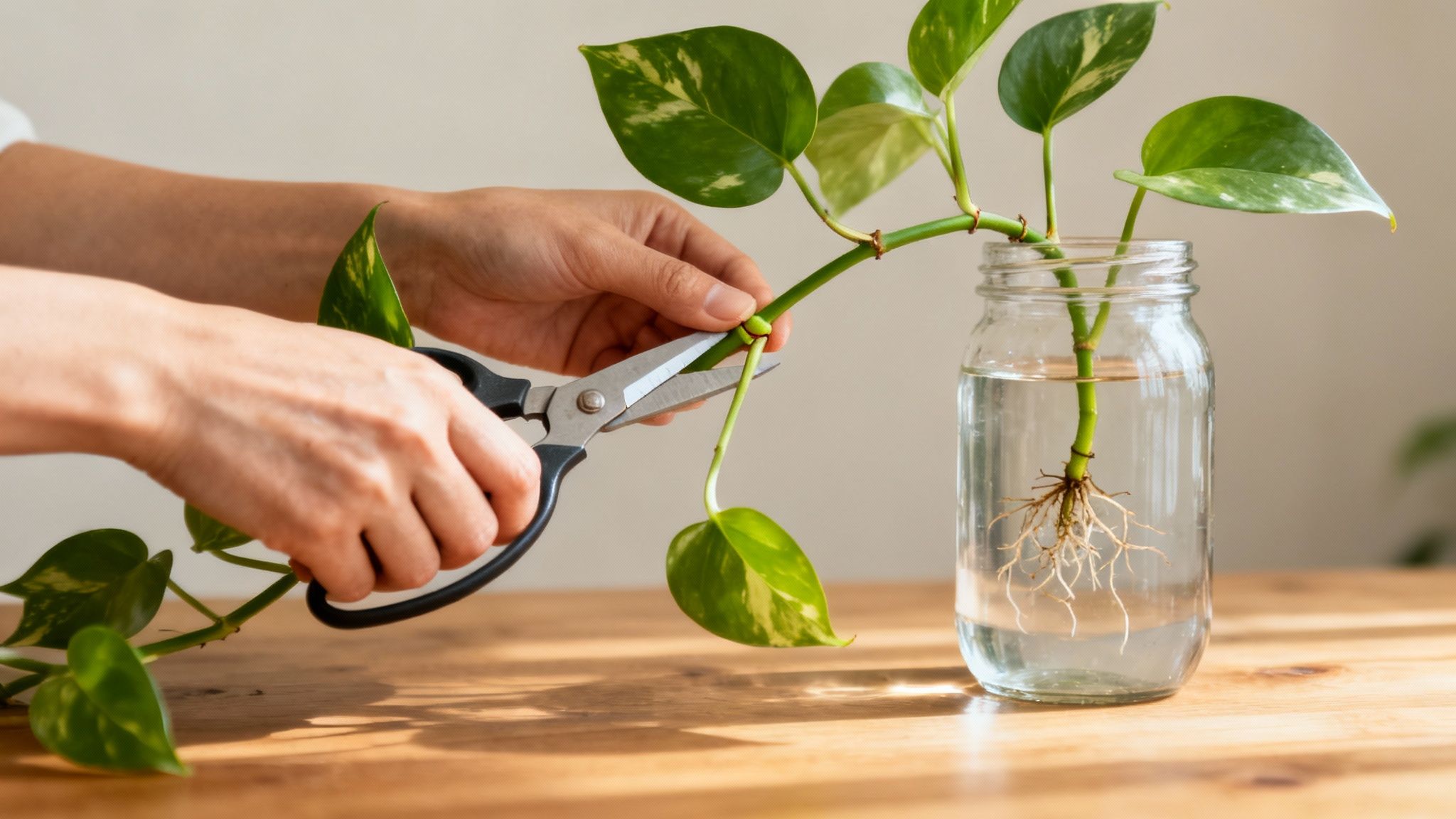
So you've mastered the basics, and your Pothos is growing. Great! Now for the fun part: moving from just keeping it alive to actively shaping it. This is where pruning comes in.
Pruning isn't just a haircut to keep your plant from taking over the room. It's the secret to transforming a few long, stringy vines into a full, bushy masterpiece. Every snip encourages your Pothos to branch out, creating that lush, dense look we all strive for.
Think of it as a conversation with your plant. By cutting a vine, you’re signaling it to stop putting energy into getting longer and instead focus on pushing out new growth closer to the base. It’s the single best way to fix that "leggy" look Pothos can get when they're stretching for light.
The Simple Art of Pruning for Fullness
First off, don't be nervous. Pothos are incredibly forgiving, so it's almost impossible to mess this up. All you need is a clean, sharp pair of scissors or pruning shears.
Take a look at your plant and pick a vine you want to shorten. Follow it down from the tip and look for the nodes—those little brown bumps on the stem where leaves and aerial roots sprout. The nodes are where the magic happens; they are the plant's growth centers. You’ll want to make your cut about a quarter-inch (around 0.5 cm) just after a node, leaving the node on the plant. Don't be shy—you can trim back a few inches or more. This will have a huge impact on the plant's fullness in just a few weeks.
Turning Cuttings into New Plants
Here's the best part: every piece you snip off is a potential new plant. Learning to propagate is one of the most rewarding parts of plant ownership. It feels like botanical wizardry, and it's surprisingly easy. Those cuttings are a fantastic, zero-cost way to expand your own jungle or share your plant obsession with friends.
That’s exactly what Tendra’s Plant Exchange Marketplace was built for. It connects you with other plant lovers in your area, making it simple to swap your extra Pothos cuttings for a new plant you’ve been eyeing. It’s the perfect way to diversify your collection and share your success.
You have two main options for rooting your Pothos cuttings, and both work incredibly well.
Method 1: Water Propagation
This is the classic for a reason. You get a front-row seat to watch the roots emerge, which is endlessly fascinating.
- Prep Your Cuttings: Make sure each cutting has at least two or three nodes and a couple of leaves. Snip off the leaf from the lowest node on the cutting—this is the spot that will go underwater.
- Place in Water: Pop the cuttings into a jar or vase of room-temperature water. You want at least one node submerged, but keep the remaining leaves out of the water to prevent them from rotting.
- Find a Bright Spot: Set the jar somewhere with plenty of bright, indirect light.
- Wait and Watch: Swap out the water weekly to keep it fresh. In about two to four weeks, you'll see little white roots sprouting from the submerged nodes.
- Time to Plant: Once the new roots are about an inch (2.5 cm) long, your cutting is ready for a pot with soil.
Method 2: Soil Propagation
You can also root cuttings directly in soil. This method skips the transplanting step and helps the new plant acclimate to its final home from day one.
- Prepare the Cutting: Get your cutting ready just like you would for water propagation. You can dip the cut end in a rooting hormone to give it a head start, though Pothos are so eager to grow that this isn't strictly necessary.
- Plant in Soil: Grab a small pot filled with a good, well-draining potting mix. Poke a hole, then insert the cutting so that at least one node is buried.
- Keep It Moist: Water the soil well. For the first few weeks, keep the soil consistently moist—not soaking wet, but never letting it dry out completely.
- Boost Humidity: To create a mini-greenhouse effect, you can cover the pot with a clear plastic bag for the first week or two. Just make sure to air it out every day.
By learning to prune and propagate, you're not just a plant owner anymore; you're a cultivator.
Exploring Popular Pothos Varieties
While the classic Golden Pothos is a superstar, the Pothos family is surprisingly diverse. Think of it less as one plant and more as a whole lineup, each with its own look. The basic care we’ve discussed applies to almost all of them. The main difference is that more colorful, variegated types might need a bit more light to keep their patterns sharp. Let's meet a few popular varieties.
The Classics and Fan Favorites
These are the tried-and-true varieties that have earned their spot in countless homes.
- Golden Pothos (Epipremnum aureum): This is the icon. Its heart-shaped green leaves are splashed with signature streaks of creamy yellow. It's tough, adaptable, and grows like a weed.
- Marble Queen Pothos (Epipremnum aureum 'Marble Queen'): A real showstopper. The leaves are heavily streaked and speckled with a crisp, creamy white. To keep that beautiful variegation, the Marble Queen needs a bit more bright, indirect light than its Golden cousin.
- Neon Pothos (Epipremnum aureum 'Neon'): You can't miss this one. The Neon Pothos has electrifying, chartreuse leaves. That color is most brilliant in bright, indirect light; in a dimmer spot, the leaves might darken.
- Jessenia Pothos (Epipremnum aureum 'Jessenia'): Often mistaken for the Marble Queen, the Jessenia has a much subtler, limey-green variegation swirled against a darker green leaf. It tends to be a slower grower.
The Rare and Unique Cultivars
Ready for something different? These varieties can be harder to track down, but their unique foliage makes them hot commodities.
- Cebu Blue Pothos (Epipremnum pinnatum 'Cebu Blue'): This one stands out with its silvery-blue, arrow-shaped leaves. As it matures and climbs, its leaves can develop stunning natural splits, or fenestrations, much like a Monstera.
- Baltic Blue Pothos (Epipremnum pinnatum 'Baltic Blue'): A close relative of the Cebu Blue, the Baltic Blue has darker, deeper green leaves with that same subtle blueish sheen. It’s also known for developing leaf fenestrations, often at a young age.
- Manjula Pothos (Epipremnum aureum 'Manjula'): A patented variety from the University of Florida, the Manjula has wide, heart-shaped leaves with distinct wavy edges and a painterly mix of creamy white, silver, and green.
Found a Pothos You Can't Place? With so many varieties, telling them apart can get tricky. If you stumble upon a mystery Pothos, Tendra's AI plant identification can solve the puzzle in seconds. Just snap a picture, and our app will scan its massive plant database to give you a confident ID and specific care tips.
How to Solve Common Pothos Problems
Even the toughest plants have off days. When your Pothos looks unwell, don't panic. The fix is usually a simple tweak to its care routine. The good news is that Pothos are famous for resisting pests and diseases. A 2023 study found that these plants had pest issues in less than 5% of households surveyed. The real troublemaker is usually overwatering, which leads to root rot in about 10% of cases. You can read more on these care-tips-for-houseplants/all-about-pothos-the-perfect-indoor-plant-for-any-space">common houseplant issues.
Decoding Yellow Leaves
Yellow leaves are your Pothos’s most common cry for help, and it’s almost always a case of too much water. Problem-Solution Scenario: You notice several yellow leaves on your Pothos. The soil feels damp, even though you watered it days ago. This is a classic sign of overwatering.
- The Fix for Overwatering: First, stop watering. Let the top two to three inches (5-7.5 cm) of soil dry out completely. If the pot still feels heavy and the soil stays wet for more than a week, you may need to perform a rescue mission. Gently un-pot the plant, look for dark, mushy roots (root rot), and repot it in fresh, dry soil.
- The Fix for Underwatering: If the yellow leaves feel crispy and the soil is bone-dry, give your plant a good drink until water flows from the drainage holes. It should perk up within a day.
Our deep-dive guide on why your plants are turning yellow can help you investigate further.
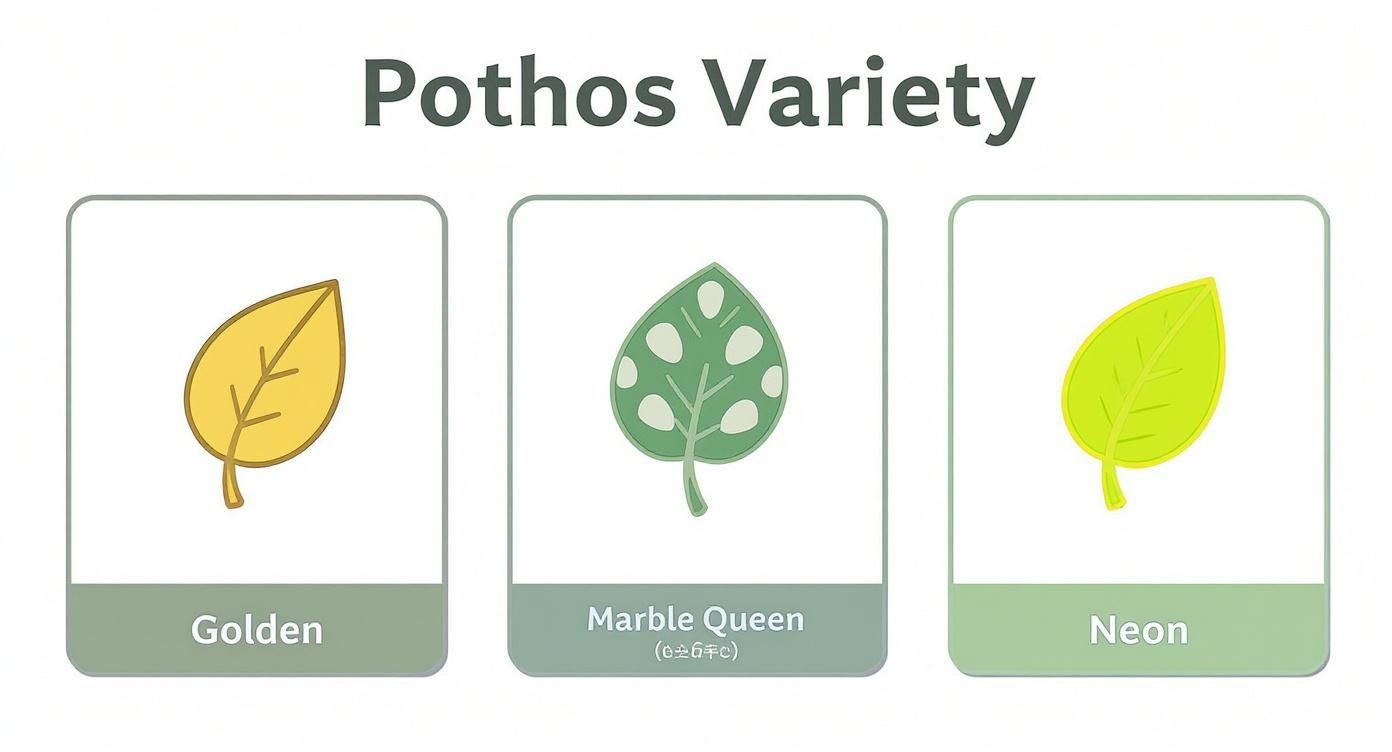 care guide">
care guide">
This visual guide highlights the unique leaf patterns of Golden, Marble Queen, and Neon Pothos—patterns that can change depending on the plant's health and environment.
Tackling Common Pests
While Pothos are pest-resistant, they can sometimes attract unwanted guests. The key is to catch them early.
Mealybugs: These look like tiny bits of white cotton. A quick dab with a cotton swab dipped in rubbing alcohol will take care of them.
Spider Mites: You'll notice their calling card: fine, silky webbing on the undersides of leaves. They thrive in dry air.
Scale Insects: Look for small, brown, shell-like bumps clinging to stems and leaves.
When You're Stumped, Tendra Can Help If you've spotted something strange on your Pothos and you're not sure what it is, don't guess. Tendra's AI disease diagnosis feature is like having a plant doctor in your pocket. Snap a photo of the affected area, and our AI will analyze it, give you a quick, accurate diagnosis, and lay out a step-by-step treatment plan.
For most pests, a gentle insecticidal soap or neem oil spray is a great first line of defense. Just mix a little with water and spray the entire plant. You might need to repeat this weekly for a few weeks to break the pest life cycle.
A Pothos Revival Story in Portland
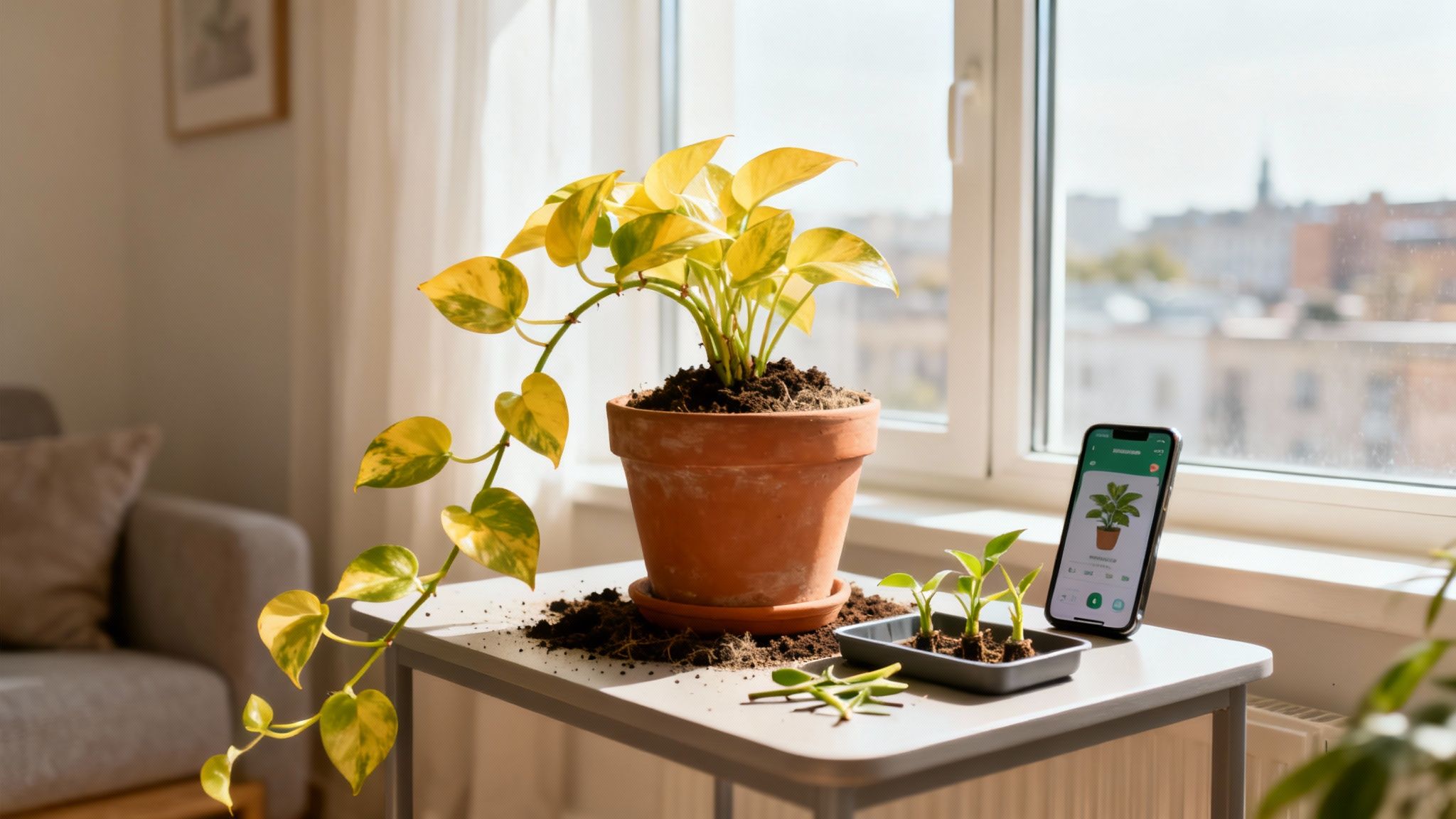
Let's bring this all together with a real-world scenario. Meet Sarah from Portland, a new plant parent. Her first plant was a gift: a sad, leggy Golden Pothos that was mostly bare vine with a few lonely leaves. Discouraged, she was close to giving up.
Instead, Sarah used the Tendra app. The AI plant identifier quickly confirmed it was Epipremnum aureum and provided its care profile. The diagnostic tool helped her pinpoint the culprits: too much water and not enough light.
Armed with a plan, Sarah repotted the Pothos in fresh, airy soil, trimming away the few mushy roots. She moved it to a spot with bright, indirect light from an east-facing window. Following our pruning guide, she bravely trimmed back the straggly vines, cutting just after a node to spark new growth. The turnaround was incredible. Within weeks, tiny new leaves unfurled along the once-bare stems. The cuttings she saved were already rooting in a jar of water.
Her Pothos went from a survivor to a vibrant showpiece. She even took the rooted cuttings to a local plant swap she found through the Tendra community feed. There, she met Nick from New York, another gardener growing Pothos. They connected through Tendra’s Twin Plant Mates feature, sharing progress and trading tips. Sarah’s single, struggling plant didn’t just survive; it kickstarted a new hobby and a new local connection.
Pothos FAQs
Here are quick answers to common Pothos mysteries from the Tendra community.
Is Pothos Toxic to Cats and Dogs?
Yes, Pothos is toxic to pets and people if ingested. The plant contains insoluble calcium oxalate crystals, which can cause irritation, swelling in the mouth, drooling, and vomiting. The best defense is to keep your Pothos on a high shelf or in a hanging basket, well out of reach.
Why Are My Pothos Leaves Not Splitting?
This is a classic case of mistaken identity! The plant famous for split leaves is the Monstera Deliciosa. While a very mature Epipremnum pinnatum variety like Cebu Blue can develop splits (fenestrations), it's rare in a typical home setting. This only happens when the plant is several years old and has been given a pole to climb.
How Do I Make My Pothos Fuller?
Regular pruning is your secret weapon. When you trim back long, trailing vines, you signal the plant to push out new growth closer to its base, preventing a "leggy" look. Practical Tip: Propagate the cuttings in water and, once rooted, plant them back into the original pot. This doubles the density, creating a seriously compact and vibrant plant.
Can Pothos Grow in Water Forever?
Absolutely! Pothos is one of the few houseplants that can live its whole life in water. Place a cutting with at least one node into a jar, keeping the leaves above the waterline. To keep it happy, swap out the water every one to two weeks to replenish oxygen. Since water lacks nutrients, add a few drops of balanced liquid fertilizer once a month.
With so many digital tools available, it's easier than ever to manage your plant care tasks. You can explore some of the best free gardening apps to elevate your green thumb and see how technology can support your growing journey.
Your Partner in Growth
Mastering Pothos care is a rewarding journey that builds confidence and brings life into your home. From understanding its basic needs for light and water to the creative arts of pruning and propagation, you now have a complete pothos care guide to ensure your plant thrives. Remember, every plant is a new opportunity to learn and grow as a gardener. With the right knowledge and supportive tools, you can transform any space into a green sanctuary.
Turn your phone into a plant expert with Tendra. Download Tendra and discover smart care reminders with Tendra - where local gardeners connect and thrive.

